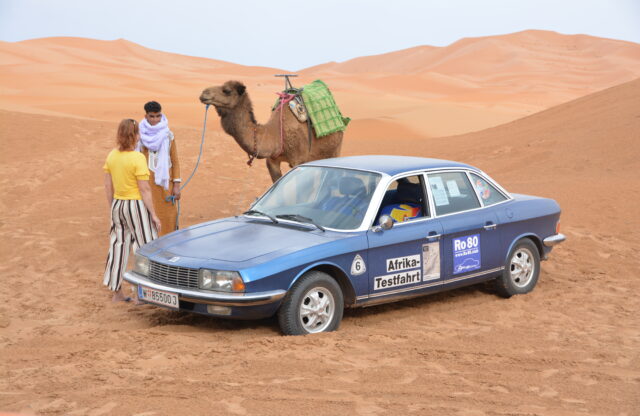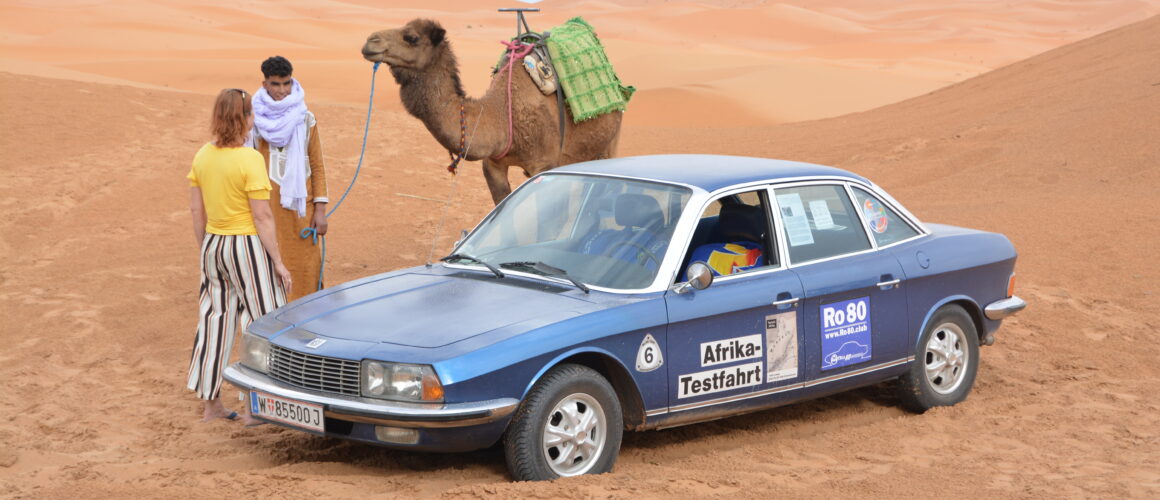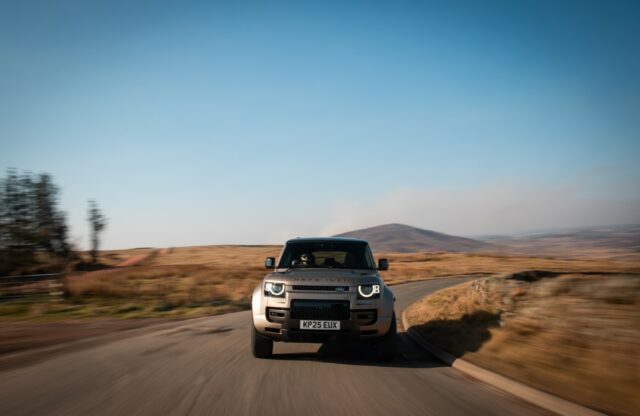WORDS: AXEL E CATTON | PHOTOS: AUTHOR, STEFFI SCHLIESSKE, ANDREAS MEYER
Some cars have had to live with a bad reputation since new, justified or not. One of them is the NSU Ro 80, despite it once having been declared Car of the Year. In addition to a two-disc rotary engine and a semi-auto ’box, Claus Luthes’ forward-thinking saloon featured a particularly modern, wedge-shaped body that still looks attractive today.
This story first appeared in Magneto issue 18.
“A reputation for poor reliability still haunts the Ro 80 – at least among those who aren’t familiar with it,” explains Gunter Olsowski, first chairman of the Ro 80 Club International. “In fact, the initial difficulties were soon under control. At that time, NSU dealers were frankly over-challenged with the new luxury car’s servicing aspects.”
True fans, however, have always known about the Neckarsulm flagship’s reliability. This was reason enough for Olsowski’s surprise phone call a few months ago: “We’re going to the Sahara!”

We’re not in Kansas anymore. The discussions are distinctly technical and clearly rotary-engine focused


In 1968, the German magazine Hobby had set off for Morocco with a Ro 80 and a Citroën DS for a so-called super test. “We thought, why don’t we recreate that?”
What started as a small group led to a gang of 14 club members and seven Ro 80s in spring 2023, some of which are lined up at Lindau’s Felix Wankel Institut. “The oldest is from 1968, the year Hobby went to Africa,” explains Andreas Meyer, second chairman of the club and one of the tour’s central planners.
Meyer and his colleagues have planned the 2400km (1500-mile) trip well, concentrating on the ’68 tour’s main locations. Hotels have all been booked via the web from home; it’s hard to imagine what planning such a tour over 50 years ago would’ve entailed, using airmail and fighting language barriers. Prices for rooms range from €90 per night in the north for business-type hotels to €27 in the Sahara.

On the very first night I realise we’re not in Kansas any more. The discussions are distinctly technical and clearly rotary-engine focused.
“What’s your pressure?” is an accepted conversation starter in these circles. “Eight in the front, ten at the back,” is the laconic answer. “How do you check it?” “With the original NSU tool.” “Is it accurate?” “Of course: I have calibrated it before.” Ah, makes sense.
After the first day’s trip to Morocco’s capital Rabat, I have to correct my views of this North African country. The coast roads are excellent, the surface smooth, the traffic light – just as in 1968, when Hobby raved about “fast roads with very little traffic obstruction”.
With daytime temperatures of 20oC, the Ro 80s don’t have to work hard. Neither do we, because there is 4G reception everywhere. The team has organised for Moroccan SIM cards loaded with 100 dirhams (about €10) that will cover the entire two weeks.
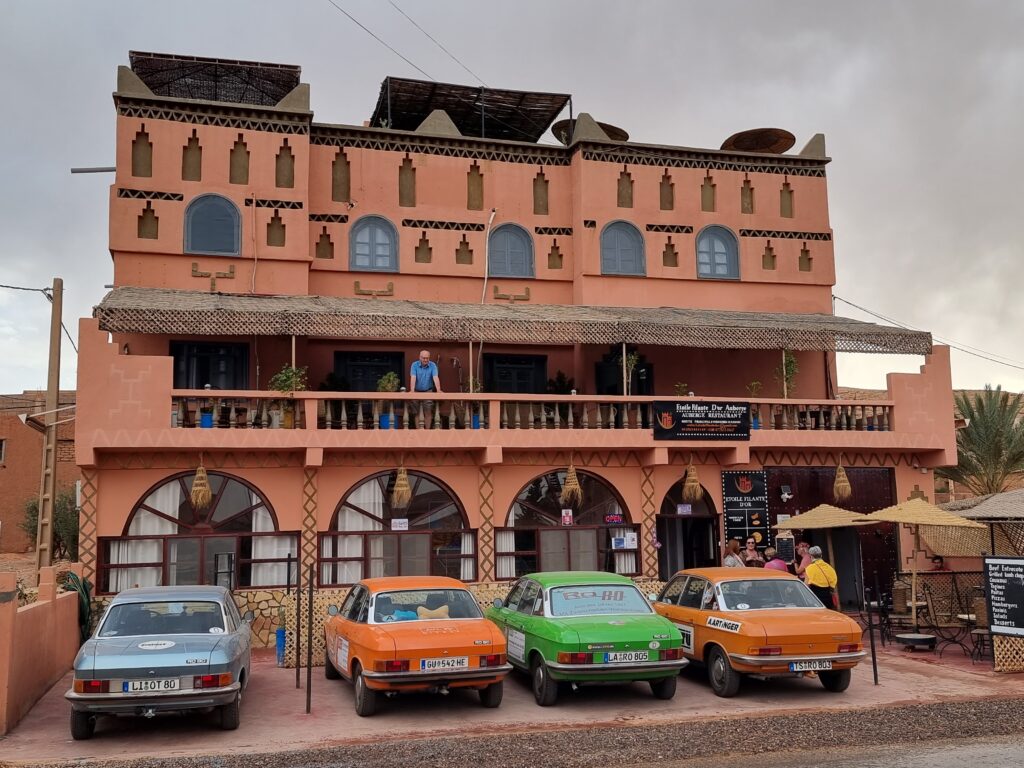
With its half-million population, Rabat gives us a taste of urban Moroccan reality. A mix of southern European-style architecture and oriental market hubbub shows how the country deals with the diverse influences of the centuries. Arabs, Berbers, Europeans; a melting pot of the most diverse cultures.
In the morning, before leaving for the south, Gunter has to take care of his car’s accelerator pump – it’s still working, but not always well. While the other teams load their vehicles, engineer Hubert Schönhammer quickly replaces the part in the hotel car park. Now off to Casablanca.
Many associate this city with Bogart and Bergman: Here’s looking at you, kid. Yet the 2023 reality could not be more different. With 3.4 million people, it is Morocco’s largest city. We pass some rather poor neighbourhoods before we get to the city-centre hotel, chosen for its safe underground car park.
In the morning, we meet Rafik Lahlou and his team from the Moroccan Classic Car Association, who lead us on a short drive along the coast to where the country’s only Formula 1 Grand Prix was held, in 1958. Returning to the association’s headquarters, we’re given a taste of real Moroccan hospitality, with a superb meal.
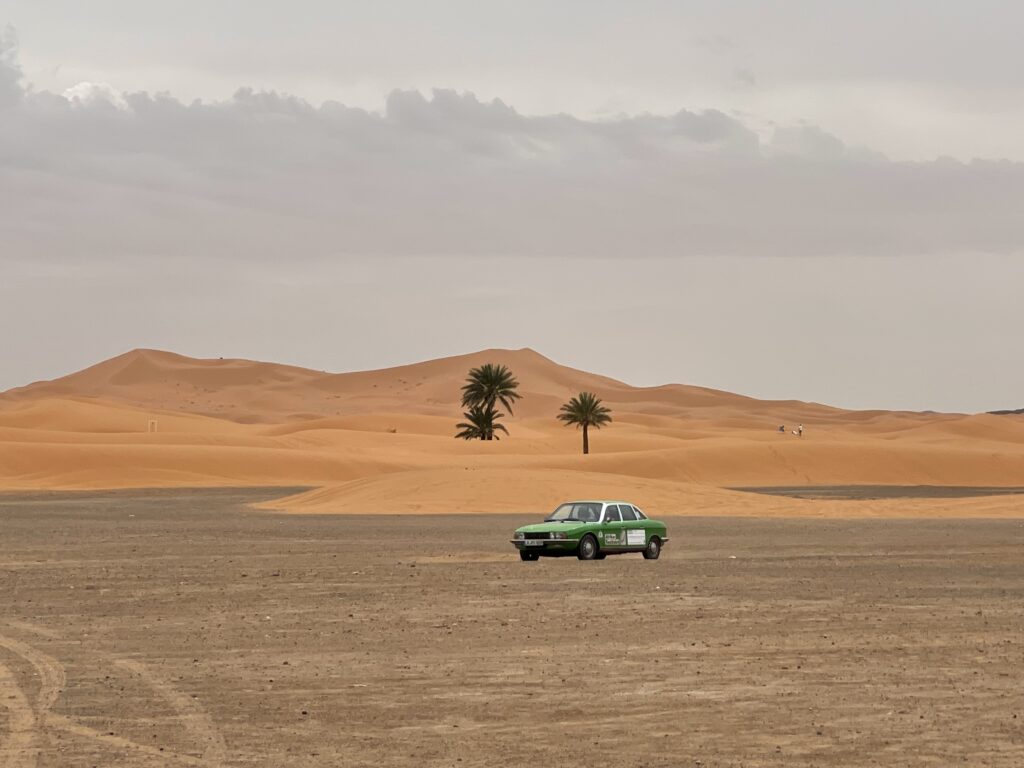
Our new friend Abdelouahad leads us with his Dacia Duster to Marrakesh, via the motorway. Here, our futuristic gliders show off their best attributes; front-wheel drive means the comfortable saloons pull as straight as any modern car. The five-seaters’ comfort, generous load space, soft suspension and subdued engine noise make them good cruisers. Only excessive wind noise dates the design from the 1960s.
After almost 600km (370 miles) it’s time to check fuel economy. It ranges from 13-13.5 litres per 100km (21-22mpg), with just one nudging 15 litres (19mpg). Oil is checked meticulously, though, with about a litre replenished every 1000km.
Marrakesh (pop. one million) is one of Morocco’s most popular tourist destinations – and at 34ºC in March, it’s our hottest point so far. The colourful Medina and market are in stark contrast to the new business architecture. Once more, we encounter overwhelming friendliness. A smile says “nice to have you here”, with no need for any words. No question this often comes with the intent of financial benefit, but who’d argue with that?
It’s a very similar experience at the seemingly never-ending police controls. We pass a checkpoint about five times a day, yet the law enforcement does not seem to be after us, because we’re continually waved through with a wide grin.
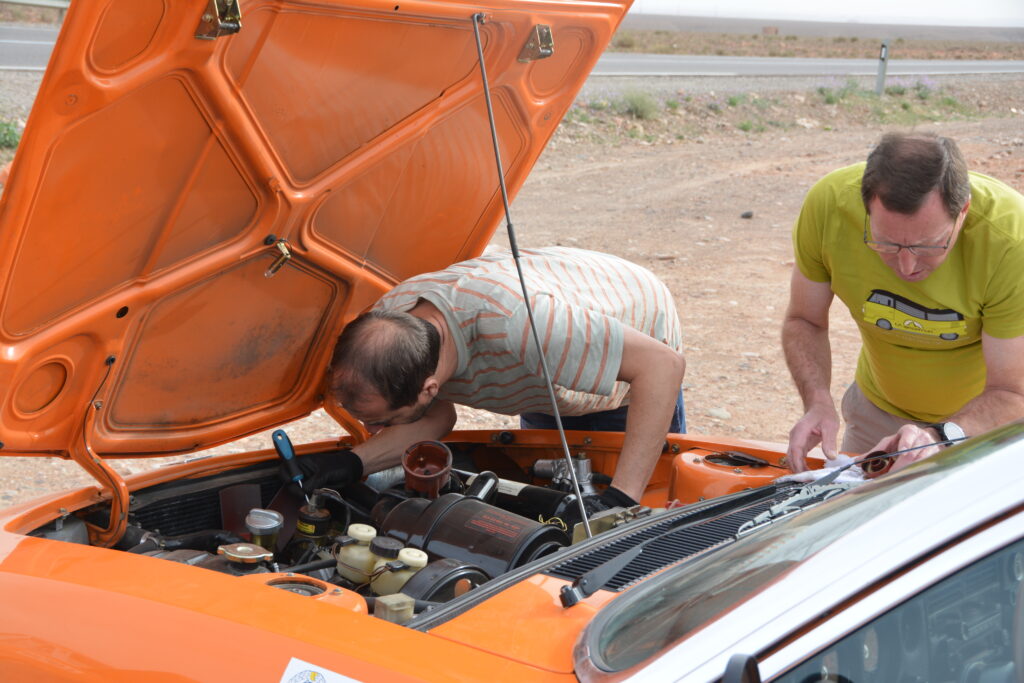
Our trip towards the Sahara brings us over the Atlas Mountains, replacing hot weather with snow, yet the 2260m Tizi n’Tichka pass is no challenge for our fleet. After an evening in Aït Benhaddou, where movie are often filmed, Morocco finally presents itself as we had imagined it. Built-up areas make way for wide-open spaces and sand – lots of sand. Because none of the cars has air-con, we drive with the windows open, which now takes its toll in the desert.
At the end of the first week, we reach our most southeastern stop, the Kasbah Erg Chebbi, a former fortress on the edge of the Sahara now specialising in desert tourism. Abdul and his colleagues enjoy our colourful line-up, and offer to lead us in their Jeeps to the places where Hobby took its legendary desert pictures 55 years ago.
The team breathes a sigh of relief at the ‘overcast’ weather forecast – how wonderful. It’s a pleasant 26oC as we head off on the short route to Taouz in the south, the last stretch of asphalt road before the Algerian border.
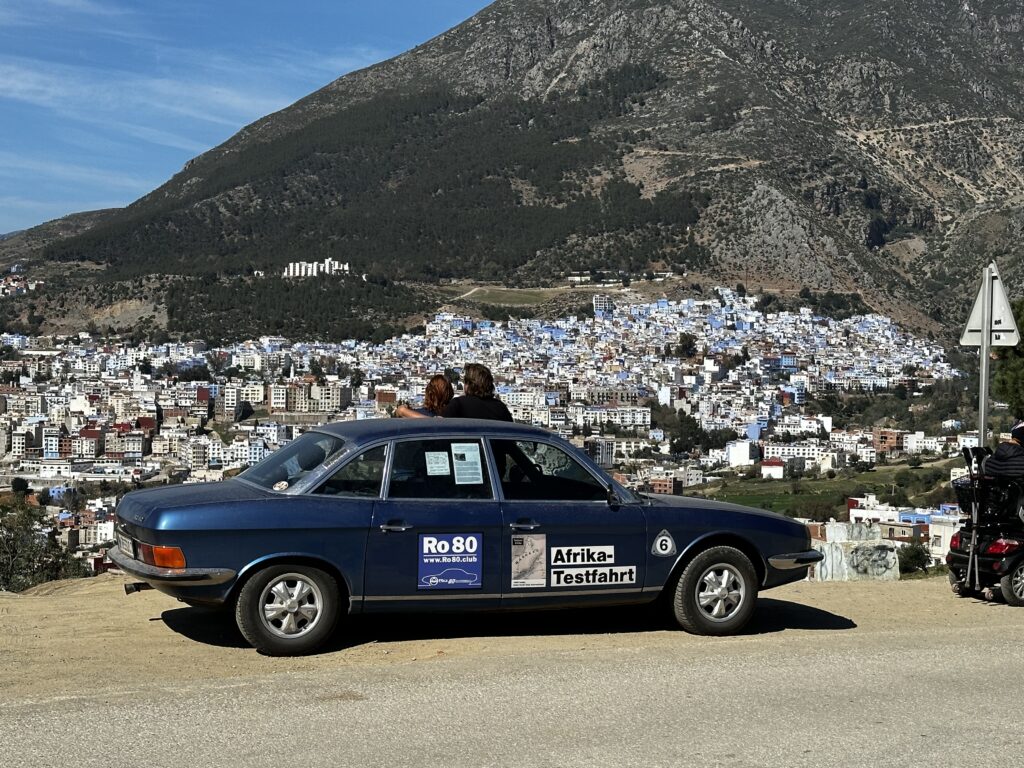
Finally, after eight days and some 3000km, seven undefeated gladiators enter the Sahara. It was all going so well – but suddenly Walter Till brings his phoenix-red 1975 Ro to a stop. “It just went out, on the washboard track,” he says.
The team soon realises that the battery cable has shaken loose. It’s reattached and we’re ready to go – but now Walter’s car is stuck. No problem; this NSU is front-wheel drive, weighs just 1200kg and there are half-a-dozen willing pushers.
Then it starts to rain. Only lightly, but enough for the wipers to come on for the first time on this trip. It leads to the tour’s only non-repairable damage; the wiper motor on Andreas Meyer’s ’68 has failed. He can’t stop laughing: “That’s not even an original NSU part; it’s off a VW Golf.” As many parts as the team has brought, no one had thought of a wiper motor.
Over the next days the caravan heads north once more to the Atlas Mountains, where we stay in a Austrian-style chalet in the rather artificial-looking Ifrane ski resort, built by French occupiers in 1928. A true out-of-body experience.
Next are the royal city of Fez and Chefchaouen, the ‘Blue City’, before we arrive back in Tangier 11 days later. In the end, the logbooks document no real damage. One accelerator pump replaced, contacts cleaned and then replaced, and one automatic choke adjusted. So were there really no breakdowns?
“Okay, yes, there was one,” Gunter giggles. “We had to leave our Moroccan friend’s Dacia behind with a damaged clutch.” But all seven Ro 80s arrived home just as they had left – only dustier.
